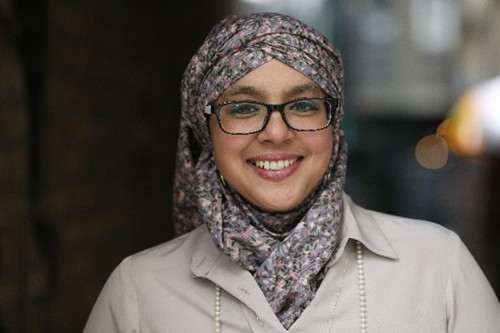05 November 2025
The Lion Above the Door: Announcing an exciting collaboration with Onjali Q. Rauf
In an exciting new collaboration for the CWGC, we are working with the award-winning and best-selling children’s author and activist, Onjali Q. Rauf.
Her books help children understand and deal with a range of issues in a narrative that they can relate to in an engaging way. One of those books The Lion Above the Door explores the importance of inclusive history and of ensuring the stories of those from all Commonwealth countries are remembered.
Sarah Nathaniel, CWGC Education Officer, talks to Onjali about her interest in the work of Commonwealth War Graves and why it is so important to share these stories.
How did you become interested in the work of the Commonwealth War Graves Commission?
 Image: Author Onjali Q Rauf
Image: Author Onjali Q Rauf
I’ve always been a huge Second World War history buff, keen to learn anything and everything I could about the Allied forces and the millions of souls that took a stand against political Nazism – my own ancestors included. I recall my A level history teacher especially talking about his own pilgrimage to the Forceville Cemetery in France and developing a vague idea that something like the CWCG existed and that it worked to honour our fallen.
But it wasn’t until I began researching the story of Second World War RAF hero, Tan Kay Hai, for my story, The Lion Above the Door, and travelling halfway around the world to pay respect to him at the Kranji War Cemetery in Singapore, that I finally got a sense of the sheer scale and magnitude of works undertaken by the global CWGC teams.
To be completely honest, I had, until that point, always tried to stay away from fields of endless tombstones; the thought of so many lives being made to pay the highest cost for events not of their making has always felt too overwhelming, too awful.
But contrary to my expectations and dread, visiting Kranji and standing at the grave of a hero, who it has changed my life to learn about, brought me a sense of peace I just wasn’t expecting. Seeing such a vast ocean of names so staggeringly and beautifully cared for was overwhelming in a whole other way I hadn’t anticipated. That was the day that brought what the CWCG teams do to life.
What made you want to write about some of our casualties in The Lion Above the Door?
 Image: The Lion above the Door by Onjali Q Rauf
Image: The Lion above the Door by Onjali Q Rauf
Growing up, I had so many questions about my Second World War history lessons; questions I couldn’t help voicing constantly – probably to the great annoyance of my teachers. The main one was, ‘Where is everyone – the soldiers and faces and stories and men and women that didn’t just come from Europe and the USA but from India, Burma, China, Algeria, Ghana, Turkey, Senegal?’
I was intensely aware, especially during the last few years of school and thanks to my own family’s ties to the then-India, that huge geographical swathes of real life and real facts were missing from our textbooks. This meant millions of men and women’s involvement from nations that lay beyond ‘the West’ had been left out, too.
Meeting thousands of children as I do each year, I know that particular question is one that lots of children – and their parents - still continue to ask. So, it was only natural that on finishing writing the story, I wanted to include s/heroes like Noor Inayat Khan, Elizabeth Choy, Adelaide Hall, Manta and Assa Singh in the back of the book for children to learn about.
I want them to know there are answers to such a question – waiting to be found, uncovered, and held up to the light for everyone else to see, read and learn about too. The quicker we can fill up the missing pages in our textbooks with the faces and names of s/heroes that should always have been there too, the quicker we can do away with the kind of ignorance that leads to the racism of today.
Why do you think it is so important that we highlight the diversity of those we commemorate?
Knowing about, and honouring ALL those who gave their lives for their children and their nations – every last one of them, no matter what country they came from, no matter their skin colour, no matter their name or social standing, no matter if they volunteered freely or were forced into a position too horrific to think on – celebrating them all is the ONLY long-term, effective way to cut through the kind of racisms, ignorance and fear that forges what I see as the baseline of ongoing warfare and civil unrest.
Deleting some people’s histories and legacies in favour of a forging a selective truth or story, leads in turn, to a distorted present – a blurred lens. If we can’t acknowledge and honour the true depth and breadth and global nature of ALL those who fell for us, then we haven’t honoured the reasons they stood and fought together. Not fully. Not yet.
One of the themes in the story is looking at women who served and died during the Second World War – why did you want to include them?
One of the other major questions I had about my history lessons was: ‘Where were all the women of the Second World War? Why did we never learn about women doing brave things to beat the Nazis!?’ I’m hopeful that finally, this particular question is being answered in new editions of textbooks and by amazing female historians releasing the names and stories of Second World War heroines (like Shrabani Basu who is solely responsible for hunting down and releasing the story of British Indian SOE agent, Noor Inayat Khan).
But, when I was at school, there wasn’t a single aspect of teaching about the war relating to women’s heroisms that went beyond a few general, almost throwaway paragraphs, about women working on farms or in ammunition factories. No names, no faces. Just general figures and percentages.
I found it incredibly frustrating and deeply galling to have to visit endless museums or read endless chapters where not a single woman’s name was mentioned. Especially when I knew from my great-grandmother and father’s stories that women stepped up in ways unprecedented and untrained for – from keeping entire families alive and suddenly managing lands and homes entirely alone, to saving wounded soldiers on battlefields as ambulance drivers and nurses, or as was the case of one Indian female RAF pilot (whose name I am still trying to find), flight-testing planes before the male soldiers got into them!
We still have a long way to go in bringing even a fraction of women’s heroisms to the fore. So, for all the girls – and boys – reading The Lion Above the Door, I wanted them to know of the lionesses who helped save the world, too. If any of them should go on asking that same question or maybe even help find more sheroes to add to our records, then my job is beyond done!
You talk in the book about a family story tree of all those who served as being interconnected. Why do you think it is so important to explore that idea in today’s world?
 Image: Onjali's novel at Kranji War Cemetery
Image: Onjali's novel at Kranji War Cemetery
Sadly, despite all this endless information at our fingertips and the world being seemingly more accessible to us than ever before, we are currently bearing witness to groups and peoples who thrive and profit from severing the concept of a shared, deep humanity. The same old tricks of screaming about differences and even encouraging the outright eradication or expulsion of human souls they don’t see as belonging in their preferred versions of the world, are at play, and feels louder than ever before.
But the simple fact is we humans, no matter our ‘tribe’, the melanin content of our skin, our geographical happenstance, our wealth, all of us are dependent on and connected to peoples near and far, seen and unseen. We always have been. Be it the trade routes of the tenth century that kept our ancestors working and surviving, or the many nations of today who we depend upon for our clothes, food, energy, jobs, stock value – even the materials which make up whatever platform we are reading these words on, we are all of us dependent on thousands of peoples and families who help make up our lives.
That global family tree is no myth: it’s the foundation of all of us, past, present and to come. And I imagine it came alive as never before for many of our ancestors, who would have stood shoulder to shoulder with complete strangers of all colours, languages, faiths and creeds, on fields they never knew existed, to defeat a force that wanted to annihilate the differences that makes us all unique, and all equally human. In my mind, anything that reminds us of that connection – and of the millions of lives it has already cost to remind us of our shared humanity – is a deeply crucial thing.
In Onjali’s novel, The Lion Above the Door, a boy named Leo discovers his name on a war memorial, which inspires him to uncover and share the stories of forgotten men and women from the Second World War. Leo and his friend Sangeeta explore some of the stories of the men and women we commemorate.
You can find out about these stories here and explore others on our For Evermore stories portal.
Onjali will also be supporting our Carol Service in December as a speaker. If you would like to attend this unique and special event in support of the Commonwealth War Graves Foundation, you can find out more and buy tickets here.
If you would like to find out about what we can offer your school or youth group, click here.
If you would like to join our new education mailing list, you can do so here.

